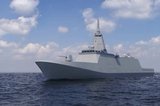TKMS enters Australian Tier 2 combatant market
When is a corvette not a corvette? Industry offerings for a 'Tier 2' combatant, which has generally been assumed to be a corvette-sized ship, have been breaking with tradition in offering much larger heavily armed ships. The MEKO A210 from TKMS would host an impressive array of multi-domain warfighting capabilities. (Photo: Tim Fish)
German shipbuilder ThyssenKrupp Marine Systems (TKMS) has joined the clamour created by the Australian Defence Strategic Review’s (DSR’s) desire to procure a new Tier 2 surface combatant for the Royal Australian Navy (RAN) by demonstrating a new MEKO A210 corvette at the Indo-Pacific Maritime exhibition in Sydney.
TKMS entered the fray with its latest design, an evolution of the company’s existing MEKO 200, which has proven successful on the international market with four batches of ship delivered to seven different countries.
The A210 corvette will be 127.5m-long and 16.7m-wide displacing some 4,750 tons, which will be on the large size for a standard corvette, but has reflected a
Already have an account? Log in
Want to keep reading this article?
More from Naval Warfare
-
![Future of the Canadian Patrol Submarine Project is still unclear]()
Future of the Canadian Patrol Submarine Project is still unclear
The Canadian government remains tight-lipped on the timeline and funding required for the next steps of its Canadian Submarine Patrol Project, which should offer improved capabilities for the country’s navy.
-
![Thales’ new Sonar 76Nano could equip UK Royal Navy on anti-submarine warfare missions]()
Thales’ new Sonar 76Nano could equip UK Royal Navy on anti-submarine warfare missions
The new sonar is designed to equip uncrewed underwater vessels, with the potential to be used by the Royal Navy for its Atlantic Bastion and Atlantic Net missions.
-
![Hanwha wins Australian government approval to increase its stake in Austal]()
Hanwha wins Australian government approval to increase its stake in Austal
The contract would mean the two shipbuilders can collaborate strategically and enhance shipbuilding capabilities in Western Australia.






















